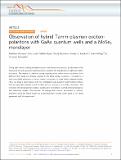Files in this item
Observation of hybrid Tamm-plasmon exciton-polaritons with GaAs quantum wells and a MoSe2 monolayer
Item metadata
| dc.contributor.author | Wurdack, Matthias | |
| dc.contributor.author | Lundt, Nils | |
| dc.contributor.author | Klaas, Martin | |
| dc.contributor.author | Baumann, Vasilij | |
| dc.contributor.author | Kavokin, Alexey | |
| dc.contributor.author | Höfling, Sven | |
| dc.contributor.author | Schneider, Christian | |
| dc.date.accessioned | 2017-08-16T16:30:09Z | |
| dc.date.available | 2017-08-16T16:30:09Z | |
| dc.date.issued | 2017-08-15 | |
| dc.identifier | 250198066 | |
| dc.identifier | 3936a240-3ac4-49ff-a74a-a763d5bd8297 | |
| dc.identifier | 85027530419 | |
| dc.identifier | 000407553800017 | |
| dc.identifier.citation | Wurdack , M , Lundt , N , Klaas , M , Baumann , V , Kavokin , A , Höfling , S & Schneider , C 2017 , ' Observation of hybrid Tamm-plasmon exciton-polaritons with GaAs quantum wells and a MoSe 2 monolayer ' , Nature Communications , vol. 8 , 259 . https://doi.org/10.1038/s41467-017-00155-w | en |
| dc.identifier.issn | 2041-1723 | |
| dc.identifier.uri | https://hdl.handle.net/10023/11492 | |
| dc.description | This work has been supported by the State of Bavaria. C.S. acknowledges financial support by the European Research Council (unLiMIt-2D project). AK acknowledged the support from the HORIZON 2020 RISE project CoExAn (Grant No. 644076). S.H and A.K acknowledge funding by the EPSRC. | en |
| dc.description.abstract | Strong light matter coupling between excitons and microcavity photons, as described in the framework of cavity quantum electrodynamics, leads to the hybridization of light and matter excitations. The regime of collective strong coupling arises, when various excitations from different host media are strongly coupled to the same optical resonance. This leads to a well-controllable admixture of various matter components in three hybrid polariton modes. Here, we study a cavity device with four embedded GaAs quantum wells hosting excitons that are spectrally matched to the A-valley exciton resonance of a MoSe2 monolayer. The formation of hybrid polariton modes is evidenced in momentum resolved photoluminescence and reflectivity studies. We describe the energy and k-vector distribution of exciton-polaritons along the hybrid modes by a thermodynamic model, which yields a very good agreement with the experiment. | |
| dc.format.extent | 6 | |
| dc.format.extent | 1275858 | |
| dc.language.iso | eng | |
| dc.relation.ispartof | Nature Communications | en |
| dc.subject | QC Physics | en |
| dc.subject | TK Electrical engineering. Electronics Nuclear engineering | en |
| dc.subject | NDAS | en |
| dc.subject | BDC | en |
| dc.subject.lcc | QC | en |
| dc.subject.lcc | TK | en |
| dc.title | Observation of hybrid Tamm-plasmon exciton-polaritons with GaAs quantum wells and a MoSe2 monolayer | en |
| dc.type | Journal article | en |
| dc.contributor.institution | University of St Andrews. School of Physics and Astronomy | en |
| dc.contributor.institution | University of St Andrews. Condensed Matter Physics | en |
| dc.identifier.doi | 10.1038/s41467-017-00155-w | |
| dc.description.status | Peer reviewed | en |
This item appears in the following Collection(s)
Items in the St Andrews Research Repository are protected by copyright, with all rights reserved, unless otherwise indicated.

